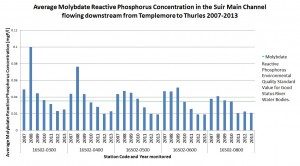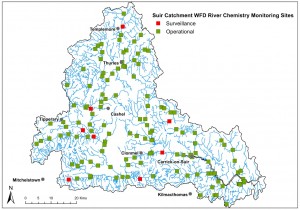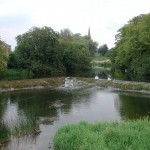What does the marine area tell us about upstream conditions?…
How chemical monitoring of our rivers can help us understand their story – why, what, where and when.
Why Monitor?
Water does not exist in its pure form in the natural environment, it is truly reflective of its surroundings, influenced by where it originates, what it flows over and percolates through. Under natural conditions the chemical characteristics of our water bodies originate from a variety of sources, including leaching of soils, weathering of minerals and atmospheric inputs. These chemicals, in both dissolved and particulate forms, reach the water body via a number of pathways, and in the case of surface water have resulted in a natural background level of chemical constituents in which aquatic biota have developed.
Water quality monitoring is fundamental in the management of water resources that support healthy and productive aquatic ecosystems as well as sustainable and healthy water supplies and chemistry monitoring is an integral part of any water monitoring programme. Analysis of chemical parameters in water bodies allows for the identification of substances that are present in the aquatic environment above their natural levels, as well as the existence and concentrations of synthetic compounds. Chemical monitoring of water bodies in Ireland is undertaken by a number of different organisations.
Monitoring for identified chemical compounds highlights any significant changes or trends that may be evident in water bodies over a period of time. Trending of monitoring data facilitates the identification of pressures placed on the aquatic system that may be resultant of long or short term developments. Focused monitoring programmes can help target the source of a pressure and help inform the measures that require implementation to reduce concentrations to levels that no longer impact on water quality. Review of chemical monitoring data can also be used to determine the relative success of applied measures.

What is monitored?
The Water Framework Directive has identified the necessity for all of our water bodies, rivers, lakes, estuaries and coastal waters, ground waters, and protected areas to be treated equally in terms of attaining at least ‘Good’ status for all, and maintaining ‘High’ status where it exists. This consolidated approach has ensured that water quality is of integral importance in current practices and future developments.
Evidence-based metrics have been developed to determine the current status of water bodies and whether a water body is at risk of not achieving ‘Good’ status. In the case of surface waters these metrics or Environmental Quality Standards specify an absolute concentration or range for a water quality element. In terms of chemical parameters these standards fall into one of three classes:
1. Physico-Chemical conditions supporting biological elements
This group includes chemical properties such as pH (acidity/alkalinity), Dissolved Oxygen and Nutrients, the natural levels of which may be adversely impacted upon by human activities.
2. Specific Relevant Pollutants
This group of compounds are defined as substances that can have a harmful effect on biological quality which are identified as being discharged in significant quantities into Irish waters.
3. Priority Substances
These substances are identified by the Water Framework Directive as substances that present a significant general risk to, or via the aquatic environment, and include chemicals, certain metals, biocides, plant protection products and dioxins. Specific measures must be implemented for the progressive reduction of discharges, emissions and losses of these substances. This group of compounds includes a subset of Priority Hazardous Substances for which measures must be taken to stop or phase out discharges, emissions and losses.
In the case of 1 and 2 above the Environmental Quality Standards are derived and applied at a member state level, so Ireland sets a standard for water bodies here based on the best available science, and compliance with these standards is a determinant in the assessment of Ecological Status. These standards can be supplemented and amended as required nationally. In the case of the Priority Substances, the Environmental Quality Standards are identified and reviewed under European Directive and are transposed into individual member state legislation, and compliance with these standards is used in the determination of Chemical Status. A combination of both Ecological Status and Chemical Status is used to determine the overall Water Framework Directive status that is applied to a water body. All chemical Environmental Quality Standards for surface waters in Ireland are set out in European Union Environmental Objectives (Surface Waters) (Amendment) Regulations 2015.
Chemical analysis of our water bodies also has a role to play in the determining the environmental occurrence of Emerging Pollutants. These are chemical compounds that are not subject to Water Framework Directive regulations but have the potential to enter the aquatic environment and are suspected or known to have adverse ecological and/or human health effects. These compounds can originate from a number of different sectors such as municipal/domestic waste waters, agriculture and industrial emissions. The Water Framework Directive mechanism by which these emerging pollutants are assessed is via a ‘Watch List’ whereby compounds are identified to be included in a member state wide monitoring programme to assess the occurrence and prevalence of these compounds in surface waters. This monitoring programme will determine whether the compounds included in the Watch List need to be added as Priority Substances and an Environmental Quality Standard determined. The First Watch List includes compounds such as estrogens, herbicides, pesticides, anti-inflammatory drugs, a sunscreen ingredient and an anti-oxidant.

Where and when are rivers monitored?
Chemical analysis included in the Water Framework Directive monitoring programme is based on a network of operational and surveillance monitoring locations which
also include provision for the monitoring of river sites identified under the OSPAR Convention1 and Freshwater Fish Directive. Operational monitoring is used to determine pressures and apply status at a water body level. Surveillance monitoring locations also inform at a water body level, but due to their spatial distribution nationally can be used in the efficient and effective design of future monitoring programmes, the assessment of long-term changes in natural conditions and the assessment of long-term changes resulting from widespread human activity.
Chemical analysis of operational monitoring locations consists of the general physico- chemical parameters and is carried out at least once a quarter on an annual basis. Monitoring of surveillance locations includes the analysis of the general physico-chemical parameters on a monthly basis and one year in the river basin management plan cycle (i.e. one year out of six) will also be monitored monthly for Priority Substances and Specific Relevant Pollutants. Supplemental monitoring and analysis in the form of investigative monitoring may also be undertaken to ascertain the magnitude and impacts of accidental pollution events, as well as helping pinpoint the causes and likely sources of longer term pollution problems. The national river monitoring network consists of 1461 operational and 180 surveillance monitoring stations, with some rivers incorporating multiple stations. In the case of the Suir catchment there are 145 Operational and 8 Surveillance River Chemistry monitoring sites as shown below.
In conclusion, chemical monitoring of our rivers is a vital tool in assessing the current state of these water bodies, as well as helping to identify pressures that may be impacting on the water quality. Chemical monitoring of rivers is not a rigid instrument of assessment, it is flexible and influenced by the often changing pressures impacting on water bodies. Quality Standards, monitoring locations and chemicals monitored are routinely reviewed and adjusted where technically feasible, in line with the best available science, to ensure the best assessment of our river waters.







